Financial Analysis Report: Mobile Embrace Company Performance Review
VerifiedAdded on 2020/05/16
|13
|2807
|58
Report
AI Summary
This report provides a comprehensive financial analysis of Mobile Embrace, an Australian mobile marketing and payment company. It examines the company's ownership structure, key financial ratios such as Return on Assets (ROA) and Return on Equity (ROE), and debt ratios, analyzing their trends from 2014 to 2017. The report delves into the company's stock performance, including monthly stock movements and a comparison with the All Ordinary Index. It calculates the Weighted Average Cost of Capital (WACC), assesses the optimal debt structure, and reviews the company's dividend policy. The analysis also includes a discussion of conservative investment strategies, the implications of a higher WACC, gearing ratios and provides recommendations based on the financial data and market trends. The report references various academic sources to support its findings.
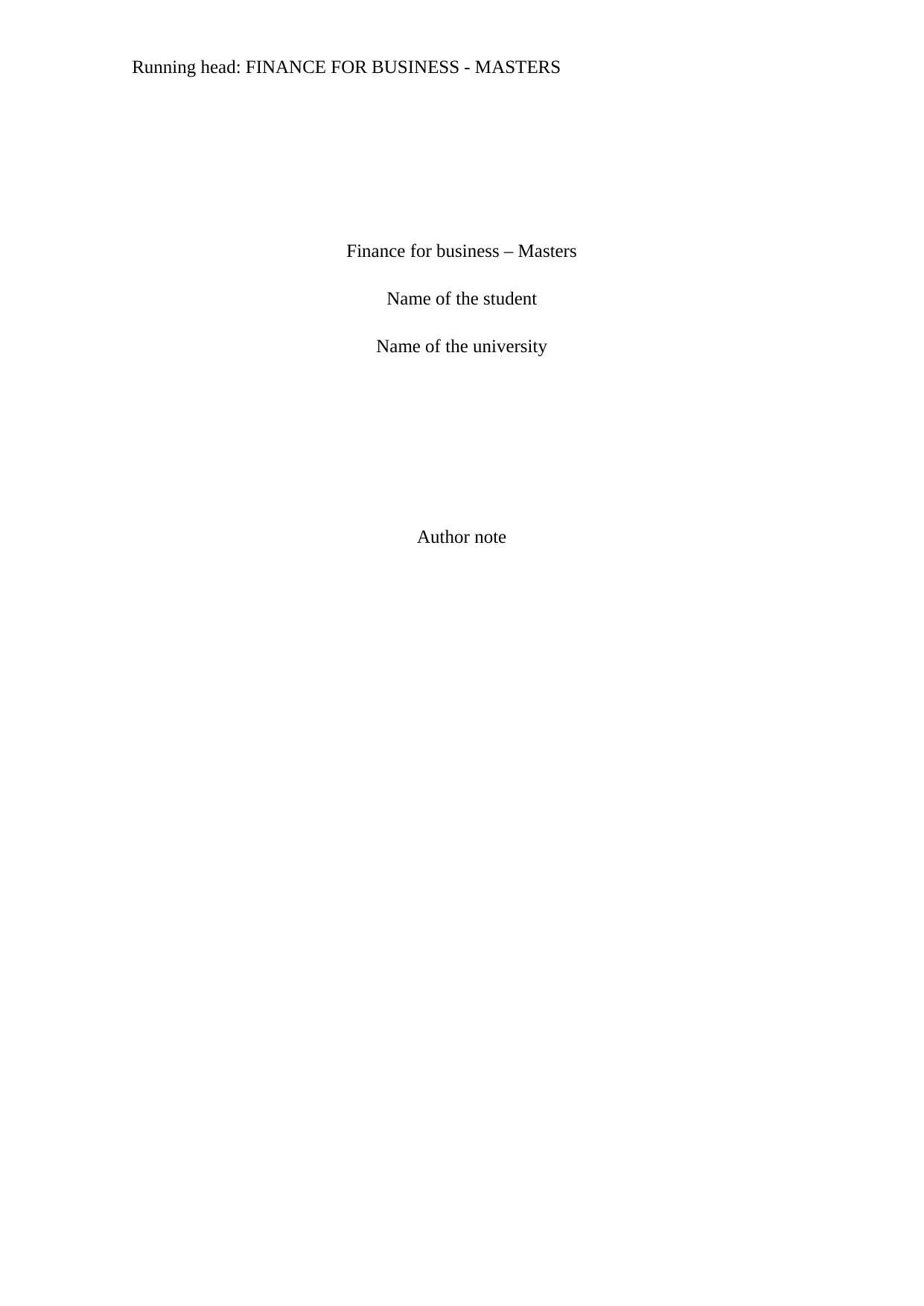
Running head: FINANCE FOR BUSINESS - MASTERS
Finance for business – Masters
Name of the student
Name of the university
Author note
Finance for business – Masters
Name of the student
Name of the university
Author note
Paraphrase This Document
Need a fresh take? Get an instant paraphrase of this document with our AI Paraphraser
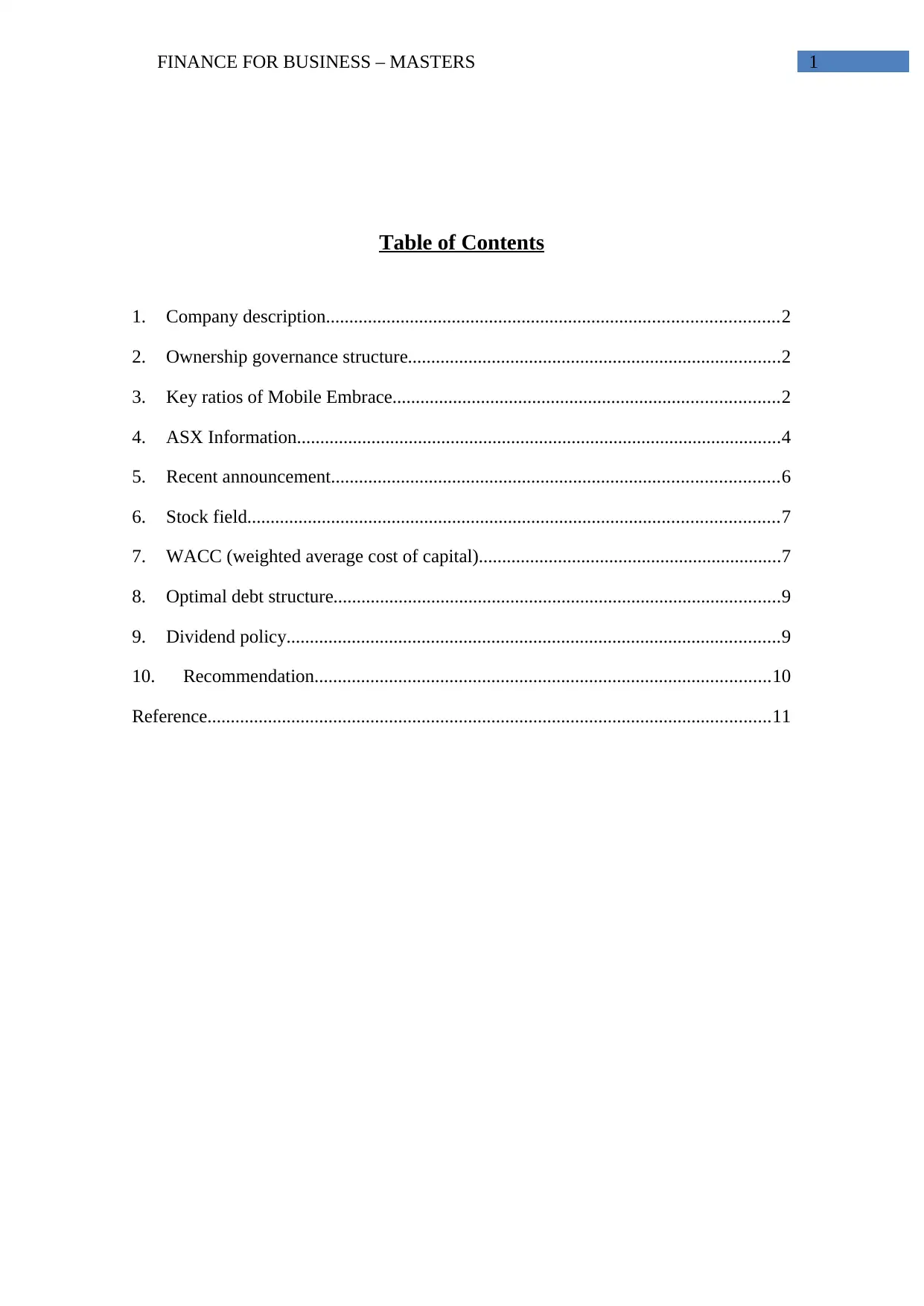
FINANCE FOR BUSINESS – MASTERS 1
Table of Contents
1. Company description.................................................................................................2
2. Ownership governance structure................................................................................2
3. Key ratios of Mobile Embrace...................................................................................2
4. ASX Information........................................................................................................4
5. Recent announcement................................................................................................6
6. Stock field..................................................................................................................7
7. WACC (weighted average cost of capital).................................................................7
8. Optimal debt structure................................................................................................9
9. Dividend policy..........................................................................................................9
10. Recommendation..................................................................................................10
Reference.........................................................................................................................11
Table of Contents
1. Company description.................................................................................................2
2. Ownership governance structure................................................................................2
3. Key ratios of Mobile Embrace...................................................................................2
4. ASX Information........................................................................................................4
5. Recent announcement................................................................................................6
6. Stock field..................................................................................................................7
7. WACC (weighted average cost of capital).................................................................7
8. Optimal debt structure................................................................................................9
9. Dividend policy..........................................................................................................9
10. Recommendation..................................................................................................10
Reference.........................................................................................................................11
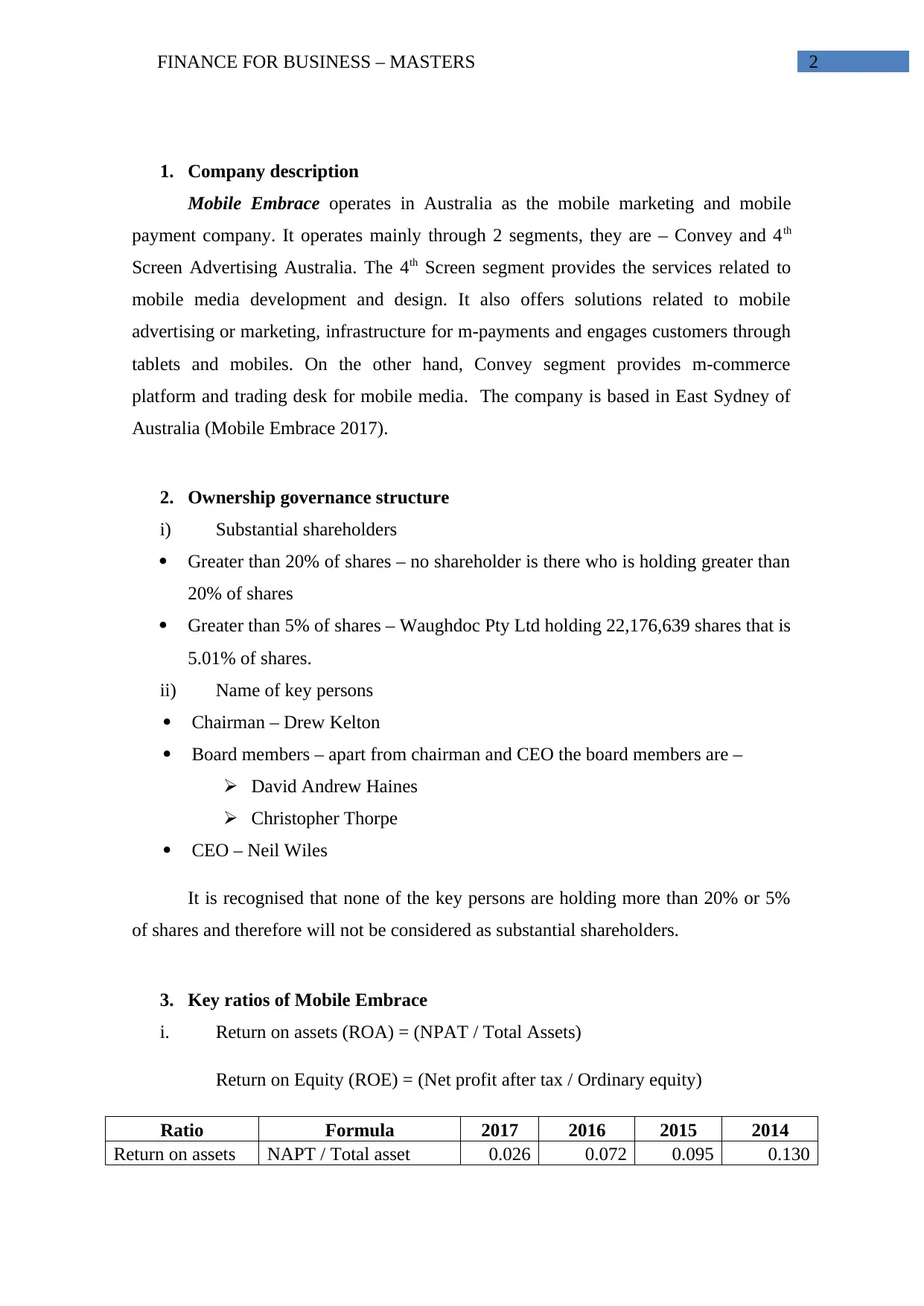
FINANCE FOR BUSINESS – MASTERS 2
1. Company description
Mobile Embrace operates in Australia as the mobile marketing and mobile
payment company. It operates mainly through 2 segments, they are – Convey and 4th
Screen Advertising Australia. The 4th Screen segment provides the services related to
mobile media development and design. It also offers solutions related to mobile
advertising or marketing, infrastructure for m-payments and engages customers through
tablets and mobiles. On the other hand, Convey segment provides m-commerce
platform and trading desk for mobile media. The company is based in East Sydney of
Australia (Mobile Embrace 2017).
2. Ownership governance structure
i) Substantial shareholders
Greater than 20% of shares – no shareholder is there who is holding greater than
20% of shares
Greater than 5% of shares – Waughdoc Pty Ltd holding 22,176,639 shares that is
5.01% of shares.
ii) Name of key persons
Chairman – Drew Kelton
Board members – apart from chairman and CEO the board members are –
David Andrew Haines
Christopher Thorpe
CEO – Neil Wiles
It is recognised that none of the key persons are holding more than 20% or 5%
of shares and therefore will not be considered as substantial shareholders.
3. Key ratios of Mobile Embrace
i. Return on assets (ROA) = (NPAT / Total Assets)
Return on Equity (ROE) = (Net profit after tax / Ordinary equity)
Ratio Formula 2017 2016 2015 2014
Return on assets NAPT / Total asset 0.026 0.072 0.095 0.130
1. Company description
Mobile Embrace operates in Australia as the mobile marketing and mobile
payment company. It operates mainly through 2 segments, they are – Convey and 4th
Screen Advertising Australia. The 4th Screen segment provides the services related to
mobile media development and design. It also offers solutions related to mobile
advertising or marketing, infrastructure for m-payments and engages customers through
tablets and mobiles. On the other hand, Convey segment provides m-commerce
platform and trading desk for mobile media. The company is based in East Sydney of
Australia (Mobile Embrace 2017).
2. Ownership governance structure
i) Substantial shareholders
Greater than 20% of shares – no shareholder is there who is holding greater than
20% of shares
Greater than 5% of shares – Waughdoc Pty Ltd holding 22,176,639 shares that is
5.01% of shares.
ii) Name of key persons
Chairman – Drew Kelton
Board members – apart from chairman and CEO the board members are –
David Andrew Haines
Christopher Thorpe
CEO – Neil Wiles
It is recognised that none of the key persons are holding more than 20% or 5%
of shares and therefore will not be considered as substantial shareholders.
3. Key ratios of Mobile Embrace
i. Return on assets (ROA) = (NPAT / Total Assets)
Return on Equity (ROE) = (Net profit after tax / Ordinary equity)
Ratio Formula 2017 2016 2015 2014
Return on assets NAPT / Total asset 0.026 0.072 0.095 0.130
⊘ This is a preview!⊘
Do you want full access?
Subscribe today to unlock all pages.

Trusted by 1+ million students worldwide

FINANCE FOR BUSINESS – MASTERS 3
Return on equity NPAT / Ordinary equity 0.038 0.123 0.135 0.148
Debt ratio = Total liabilities / Total assets
Ratio Formula 2017 2016 2015 2014
Debt ratio Total liabilities / Total assets 0.305 0.418 0.295 0.120
EBIT/TA * NPAT/EBIT * TA/OE = NPAT/OE
EBIT/TA * NPAT/EBIT * TA/OE = 10,35,812/603,65,057 * 15,95,677/10,35,812 *
603,65,057/419,77,943 = 0.038
NPAT/OE = 15,95,677 / 419,77,943 = 0.038
Hence, from above calculation it can be proved that –
EBIT/TA * NPAT/EBIT * TA/OE = NPAT/OE
ii. Phenomenon of TA/OE variable
It equation stands for the total assets of the company against its owners equity. It
is based on various factors like the industry status, economic status and revenue earning
capacity of the company. If the total asset goes up it will reduce the return on asset. On
the contrary when the total asset goes down it will increase the company’s return on the
asset (Halili, Saleh and Zeitun 2015). There is no ideal average for the total asset to
owner’s equity ratio. However, the high ratio states that the company is stable and will
be considered sustainable for long term.
iii. Reasons for higher ROE as compared to ROA
ROE or return on equity is net income that is returned as the percentage of the
owner’s equity. It measures the profitability of the company through revealing the
amount of profit the company generates with shareholders invested money. On the other
hand, ROA or the return on assets indicates the profitability of the company as
compared to the total assets. It gives the idea regarding the efficiency of the
management to use its assets for generating earnings. It is calculated by dividing the net
income of the company by its total assets and is shown in percentage form. ROE higher
Return on equity NPAT / Ordinary equity 0.038 0.123 0.135 0.148
Debt ratio = Total liabilities / Total assets
Ratio Formula 2017 2016 2015 2014
Debt ratio Total liabilities / Total assets 0.305 0.418 0.295 0.120
EBIT/TA * NPAT/EBIT * TA/OE = NPAT/OE
EBIT/TA * NPAT/EBIT * TA/OE = 10,35,812/603,65,057 * 15,95,677/10,35,812 *
603,65,057/419,77,943 = 0.038
NPAT/OE = 15,95,677 / 419,77,943 = 0.038
Hence, from above calculation it can be proved that –
EBIT/TA * NPAT/EBIT * TA/OE = NPAT/OE
ii. Phenomenon of TA/OE variable
It equation stands for the total assets of the company against its owners equity. It
is based on various factors like the industry status, economic status and revenue earning
capacity of the company. If the total asset goes up it will reduce the return on asset. On
the contrary when the total asset goes down it will increase the company’s return on the
asset (Halili, Saleh and Zeitun 2015). There is no ideal average for the total asset to
owner’s equity ratio. However, the high ratio states that the company is stable and will
be considered sustainable for long term.
iii. Reasons for higher ROE as compared to ROA
ROE or return on equity is net income that is returned as the percentage of the
owner’s equity. It measures the profitability of the company through revealing the
amount of profit the company generates with shareholders invested money. On the other
hand, ROA or the return on assets indicates the profitability of the company as
compared to the total assets. It gives the idea regarding the efficiency of the
management to use its assets for generating earnings. It is calculated by dividing the net
income of the company by its total assets and is shown in percentage form. ROE higher
Paraphrase This Document
Need a fresh take? Get an instant paraphrase of this document with our AI Paraphraser
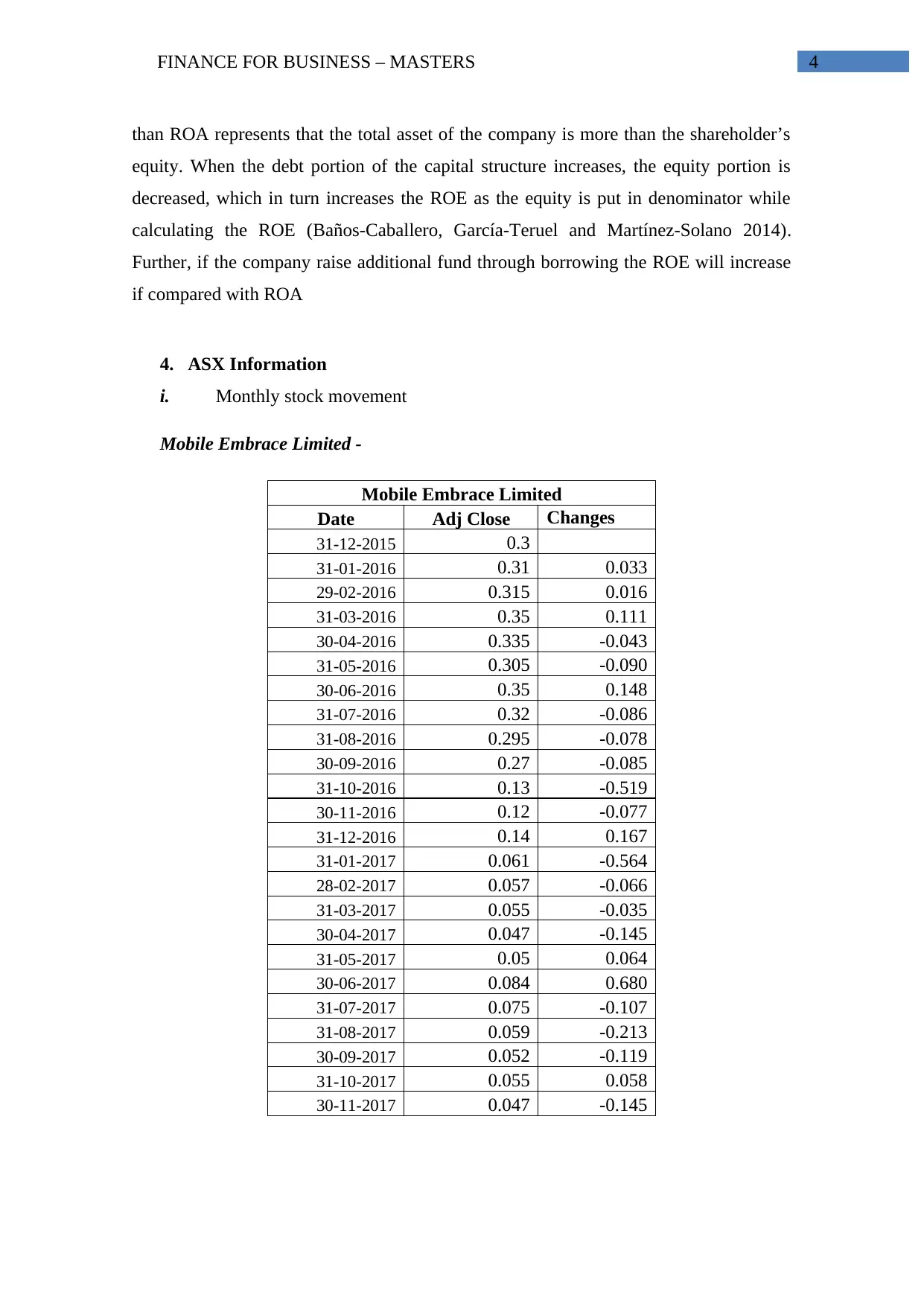
FINANCE FOR BUSINESS – MASTERS 4
than ROA represents that the total asset of the company is more than the shareholder’s
equity. When the debt portion of the capital structure increases, the equity portion is
decreased, which in turn increases the ROE as the equity is put in denominator while
calculating the ROE (Baños-Caballero, García-Teruel and Martínez-Solano 2014).
Further, if the company raise additional fund through borrowing the ROE will increase
if compared with ROA
4. ASX Information
i. Monthly stock movement
Mobile Embrace Limited -
Mobile Embrace Limited
Date Adj Close Changes
31-12-2015 0.3
31-01-2016 0.31 0.033
29-02-2016 0.315 0.016
31-03-2016 0.35 0.111
30-04-2016 0.335 -0.043
31-05-2016 0.305 -0.090
30-06-2016 0.35 0.148
31-07-2016 0.32 -0.086
31-08-2016 0.295 -0.078
30-09-2016 0.27 -0.085
31-10-2016 0.13 -0.519
30-11-2016 0.12 -0.077
31-12-2016 0.14 0.167
31-01-2017 0.061 -0.564
28-02-2017 0.057 -0.066
31-03-2017 0.055 -0.035
30-04-2017 0.047 -0.145
31-05-2017 0.05 0.064
30-06-2017 0.084 0.680
31-07-2017 0.075 -0.107
31-08-2017 0.059 -0.213
30-09-2017 0.052 -0.119
31-10-2017 0.055 0.058
30-11-2017 0.047 -0.145
than ROA represents that the total asset of the company is more than the shareholder’s
equity. When the debt portion of the capital structure increases, the equity portion is
decreased, which in turn increases the ROE as the equity is put in denominator while
calculating the ROE (Baños-Caballero, García-Teruel and Martínez-Solano 2014).
Further, if the company raise additional fund through borrowing the ROE will increase
if compared with ROA
4. ASX Information
i. Monthly stock movement
Mobile Embrace Limited -
Mobile Embrace Limited
Date Adj Close Changes
31-12-2015 0.3
31-01-2016 0.31 0.033
29-02-2016 0.315 0.016
31-03-2016 0.35 0.111
30-04-2016 0.335 -0.043
31-05-2016 0.305 -0.090
30-06-2016 0.35 0.148
31-07-2016 0.32 -0.086
31-08-2016 0.295 -0.078
30-09-2016 0.27 -0.085
31-10-2016 0.13 -0.519
30-11-2016 0.12 -0.077
31-12-2016 0.14 0.167
31-01-2017 0.061 -0.564
28-02-2017 0.057 -0.066
31-03-2017 0.055 -0.035
30-04-2017 0.047 -0.145
31-05-2017 0.05 0.064
30-06-2017 0.084 0.680
31-07-2017 0.075 -0.107
31-08-2017 0.059 -0.213
30-09-2017 0.052 -0.119
31-10-2017 0.055 0.058
30-11-2017 0.047 -0.145
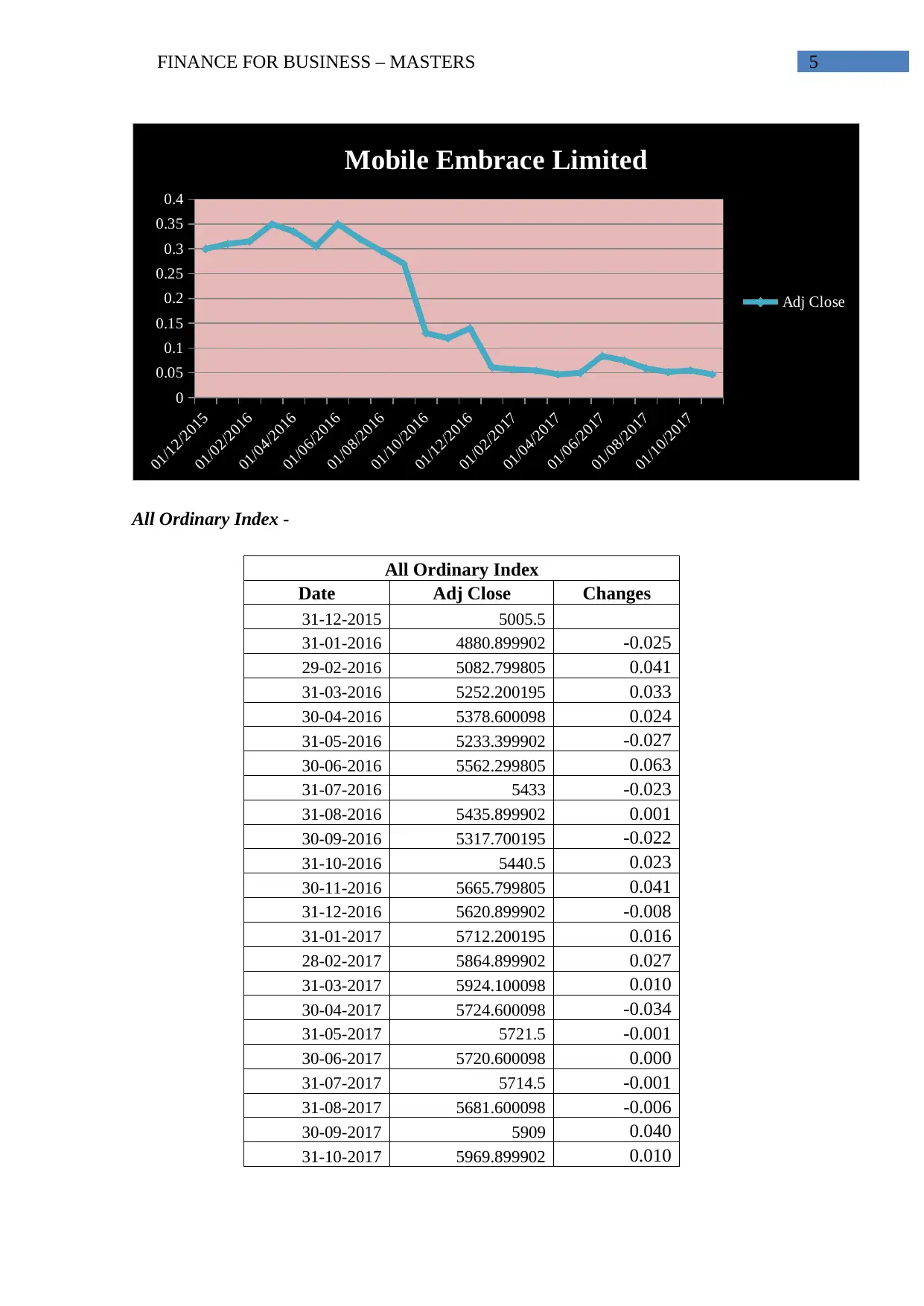
FINANCE FOR BUSINESS – MASTERS 5
01/12/2015
01/02/2016
01/04/2016
01/06/2016
01/08/2016
01/10/2016
01/12/2016
01/02/2017
01/04/2017
01/06/2017
01/08/2017
01/10/2017
0
0.05
0.1
0.15
0.2
0.25
0.3
0.35
0.4
Mobile Embrace Limited
Adj Close
All Ordinary Index -
All Ordinary Index
Date Adj Close Changes
31-12-2015 5005.5
31-01-2016 4880.899902 -0.025
29-02-2016 5082.799805 0.041
31-03-2016 5252.200195 0.033
30-04-2016 5378.600098 0.024
31-05-2016 5233.399902 -0.027
30-06-2016 5562.299805 0.063
31-07-2016 5433 -0.023
31-08-2016 5435.899902 0.001
30-09-2016 5317.700195 -0.022
31-10-2016 5440.5 0.023
30-11-2016 5665.799805 0.041
31-12-2016 5620.899902 -0.008
31-01-2017 5712.200195 0.016
28-02-2017 5864.899902 0.027
31-03-2017 5924.100098 0.010
30-04-2017 5724.600098 -0.034
31-05-2017 5721.5 -0.001
30-06-2017 5720.600098 0.000
31-07-2017 5714.5 -0.001
31-08-2017 5681.600098 -0.006
30-09-2017 5909 0.040
31-10-2017 5969.899902 0.010
01/12/2015
01/02/2016
01/04/2016
01/06/2016
01/08/2016
01/10/2016
01/12/2016
01/02/2017
01/04/2017
01/06/2017
01/08/2017
01/10/2017
0
0.05
0.1
0.15
0.2
0.25
0.3
0.35
0.4
Mobile Embrace Limited
Adj Close
All Ordinary Index -
All Ordinary Index
Date Adj Close Changes
31-12-2015 5005.5
31-01-2016 4880.899902 -0.025
29-02-2016 5082.799805 0.041
31-03-2016 5252.200195 0.033
30-04-2016 5378.600098 0.024
31-05-2016 5233.399902 -0.027
30-06-2016 5562.299805 0.063
31-07-2016 5433 -0.023
31-08-2016 5435.899902 0.001
30-09-2016 5317.700195 -0.022
31-10-2016 5440.5 0.023
30-11-2016 5665.799805 0.041
31-12-2016 5620.899902 -0.008
31-01-2017 5712.200195 0.016
28-02-2017 5864.899902 0.027
31-03-2017 5924.100098 0.010
30-04-2017 5724.600098 -0.034
31-05-2017 5721.5 -0.001
30-06-2017 5720.600098 0.000
31-07-2017 5714.5 -0.001
31-08-2017 5681.600098 -0.006
30-09-2017 5909 0.040
31-10-2017 5969.899902 0.010
⊘ This is a preview!⊘
Do you want full access?
Subscribe today to unlock all pages.

Trusted by 1+ million students worldwide
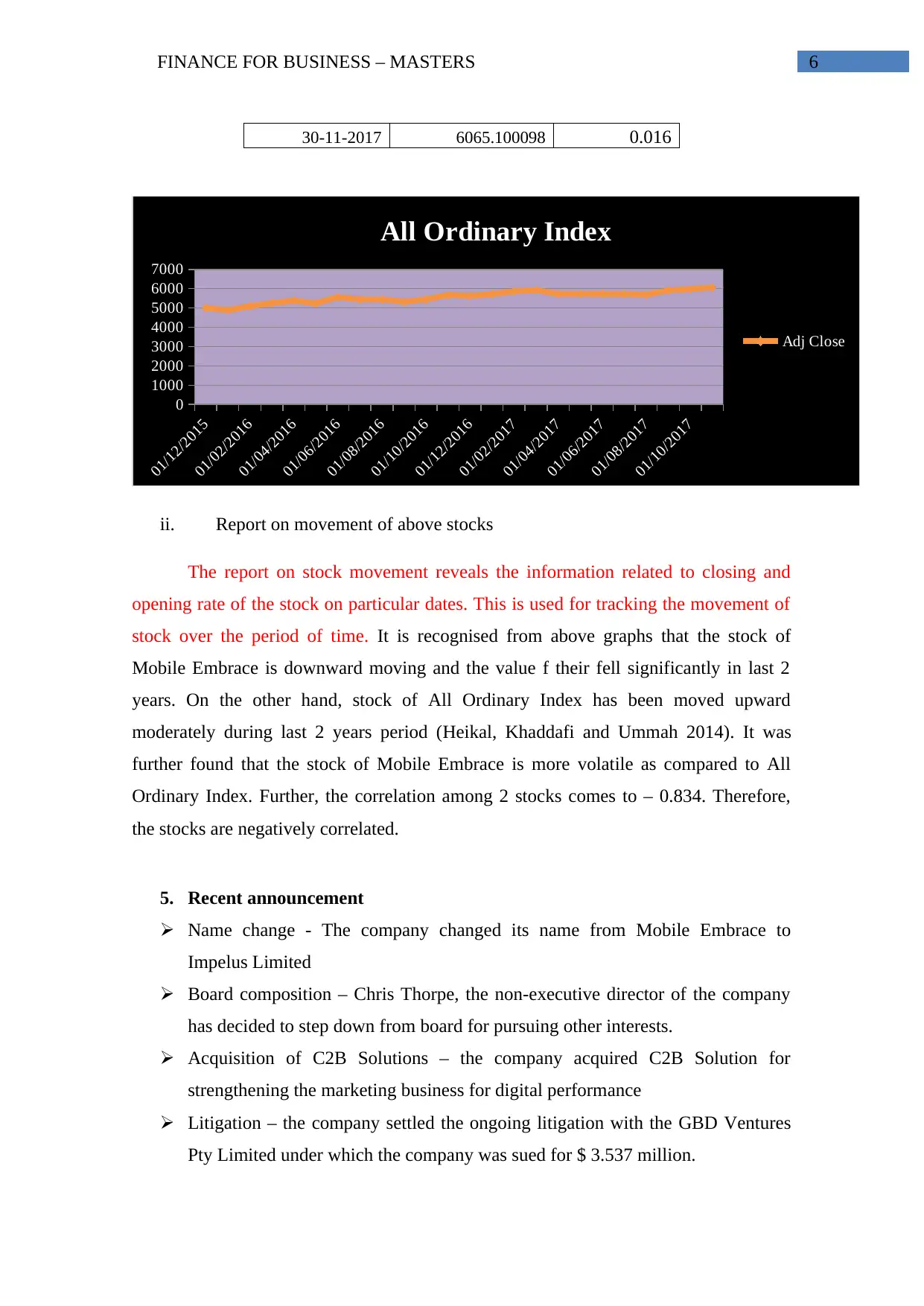
FINANCE FOR BUSINESS – MASTERS 6
30-11-2017 6065.100098 0.016
01/12/2015
01/02/2016
01/04/2016
01/06/2016
01/08/2016
01/10/2016
01/12/2016
01/02/2017
01/04/2017
01/06/2017
01/08/2017
01/10/2017
0
1000
2000
3000
4000
5000
6000
7000
All Ordinary Index
Adj Close
ii. Report on movement of above stocks
The report on stock movement reveals the information related to closing and
opening rate of the stock on particular dates. This is used for tracking the movement of
stock over the period of time. It is recognised from above graphs that the stock of
Mobile Embrace is downward moving and the value f their fell significantly in last 2
years. On the other hand, stock of All Ordinary Index has been moved upward
moderately during last 2 years period (Heikal, Khaddafi and Ummah 2014). It was
further found that the stock of Mobile Embrace is more volatile as compared to All
Ordinary Index. Further, the correlation among 2 stocks comes to – 0.834. Therefore,
the stocks are negatively correlated.
5. Recent announcement
Name change - The company changed its name from Mobile Embrace to
Impelus Limited
Board composition – Chris Thorpe, the non-executive director of the company
has decided to step down from board for pursuing other interests.
Acquisition of C2B Solutions – the company acquired C2B Solution for
strengthening the marketing business for digital performance
Litigation – the company settled the ongoing litigation with the GBD Ventures
Pty Limited under which the company was sued for $ 3.537 million.
30-11-2017 6065.100098 0.016
01/12/2015
01/02/2016
01/04/2016
01/06/2016
01/08/2016
01/10/2016
01/12/2016
01/02/2017
01/04/2017
01/06/2017
01/08/2017
01/10/2017
0
1000
2000
3000
4000
5000
6000
7000
All Ordinary Index
Adj Close
ii. Report on movement of above stocks
The report on stock movement reveals the information related to closing and
opening rate of the stock on particular dates. This is used for tracking the movement of
stock over the period of time. It is recognised from above graphs that the stock of
Mobile Embrace is downward moving and the value f their fell significantly in last 2
years. On the other hand, stock of All Ordinary Index has been moved upward
moderately during last 2 years period (Heikal, Khaddafi and Ummah 2014). It was
further found that the stock of Mobile Embrace is more volatile as compared to All
Ordinary Index. Further, the correlation among 2 stocks comes to – 0.834. Therefore,
the stocks are negatively correlated.
5. Recent announcement
Name change - The company changed its name from Mobile Embrace to
Impelus Limited
Board composition – Chris Thorpe, the non-executive director of the company
has decided to step down from board for pursuing other interests.
Acquisition of C2B Solutions – the company acquired C2B Solution for
strengthening the marketing business for digital performance
Litigation – the company settled the ongoing litigation with the GBD Ventures
Pty Limited under which the company was sued for $ 3.537 million.
Paraphrase This Document
Need a fresh take? Get an instant paraphrase of this document with our AI Paraphraser
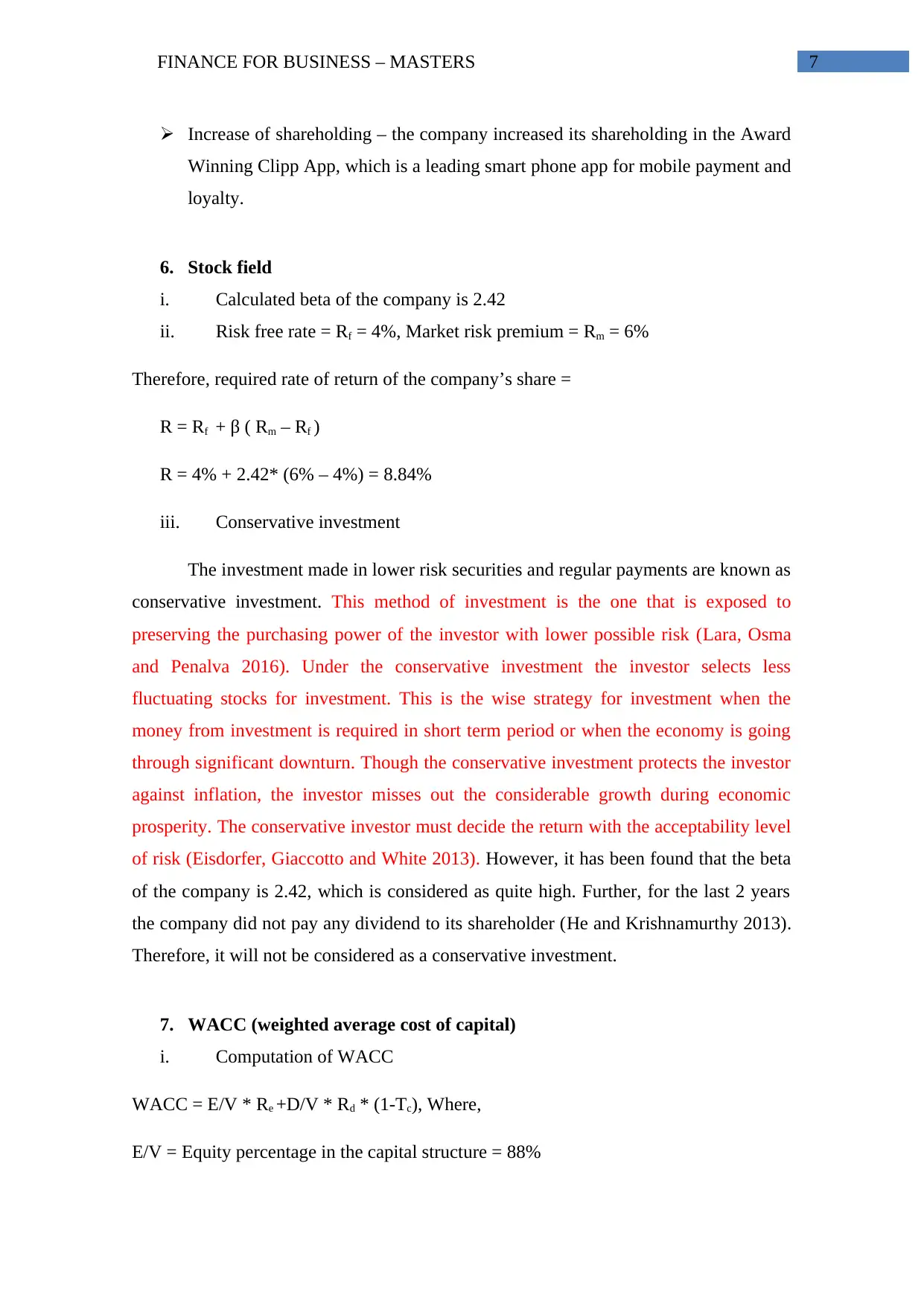
FINANCE FOR BUSINESS – MASTERS 7
Increase of shareholding – the company increased its shareholding in the Award
Winning Clipp App, which is a leading smart phone app for mobile payment and
loyalty.
6. Stock field
i. Calculated beta of the company is 2.42
ii. Risk free rate = Rf = 4%, Market risk premium = Rm = 6%
Therefore, required rate of return of the company’s share =
R = Rf + β ( Rm – Rf )
R = 4% + 2.42* (6% – 4%) = 8.84%
iii. Conservative investment
The investment made in lower risk securities and regular payments are known as
conservative investment. This method of investment is the one that is exposed to
preserving the purchasing power of the investor with lower possible risk (Lara, Osma
and Penalva 2016). Under the conservative investment the investor selects less
fluctuating stocks for investment. This is the wise strategy for investment when the
money from investment is required in short term period or when the economy is going
through significant downturn. Though the conservative investment protects the investor
against inflation, the investor misses out the considerable growth during economic
prosperity. The conservative investor must decide the return with the acceptability level
of risk (Eisdorfer, Giaccotto and White 2013). However, it has been found that the beta
of the company is 2.42, which is considered as quite high. Further, for the last 2 years
the company did not pay any dividend to its shareholder (He and Krishnamurthy 2013).
Therefore, it will not be considered as a conservative investment.
7. WACC (weighted average cost of capital)
i. Computation of WACC
WACC = E/V * Re +D/V * Rd * (1-Tc), Where,
E/V = Equity percentage in the capital structure = 88%
Increase of shareholding – the company increased its shareholding in the Award
Winning Clipp App, which is a leading smart phone app for mobile payment and
loyalty.
6. Stock field
i. Calculated beta of the company is 2.42
ii. Risk free rate = Rf = 4%, Market risk premium = Rm = 6%
Therefore, required rate of return of the company’s share =
R = Rf + β ( Rm – Rf )
R = 4% + 2.42* (6% – 4%) = 8.84%
iii. Conservative investment
The investment made in lower risk securities and regular payments are known as
conservative investment. This method of investment is the one that is exposed to
preserving the purchasing power of the investor with lower possible risk (Lara, Osma
and Penalva 2016). Under the conservative investment the investor selects less
fluctuating stocks for investment. This is the wise strategy for investment when the
money from investment is required in short term period or when the economy is going
through significant downturn. Though the conservative investment protects the investor
against inflation, the investor misses out the considerable growth during economic
prosperity. The conservative investor must decide the return with the acceptability level
of risk (Eisdorfer, Giaccotto and White 2013). However, it has been found that the beta
of the company is 2.42, which is considered as quite high. Further, for the last 2 years
the company did not pay any dividend to its shareholder (He and Krishnamurthy 2013).
Therefore, it will not be considered as a conservative investment.
7. WACC (weighted average cost of capital)
i. Computation of WACC
WACC = E/V * Re +D/V * Rd * (1-Tc), Where,
E/V = Equity percentage in the capital structure = 88%

FINANCE FOR BUSINESS – MASTERS 8
D/V = Debt percentage in the capital structure = 12%
Re = Cost of equity = 8.84%
Rd = Rate of debt = 1.02%
Tc = corporate tax rate = 30%
The given information for computation of WACC are as follows –
Amount in $'000
Amount of Debt 59,94,380.00
Amount of Equity 419,77,943.00
Total 479,72,323.00
Percentage of debt 12%
Percentage of equity 88%
Thus, WACC = 88*8.84% + 12*1.02% (1- 0.30)
= 7.78 + 0.09 = 7.86%
ii. Implication of higher WACC
WACC or the weighted average cost of capital is average of minimum after-tax
requirement for rate of return that the firm must be able to earn for its shareholders. The
WACC is measured through finding the cast of each capital component and then
multiplied it by its percentage to total capital and finally summing up all the cost
(Arsov, Shanahan and Williams 2013). It is an important tool as it analyses whether the
particular project is able to increase shareholders wealth or not. Higher WACC
represents that the company is highly leveraged and associated with higher level of
capital risk. Therefore, the management shall raise additional fund through cheaper
source of capital that is the fund with lower level of risk and cost (Zabarankin, Pavlikov
and Uryasev 2014).
8. Optimal debt structure
i. Optimal structure for capital
Debt ratio Total liabilities / Total assets Year 2017 = 0.305 Year 2016 = 0.418
D/V = Debt percentage in the capital structure = 12%
Re = Cost of equity = 8.84%
Rd = Rate of debt = 1.02%
Tc = corporate tax rate = 30%
The given information for computation of WACC are as follows –
Amount in $'000
Amount of Debt 59,94,380.00
Amount of Equity 419,77,943.00
Total 479,72,323.00
Percentage of debt 12%
Percentage of equity 88%
Thus, WACC = 88*8.84% + 12*1.02% (1- 0.30)
= 7.78 + 0.09 = 7.86%
ii. Implication of higher WACC
WACC or the weighted average cost of capital is average of minimum after-tax
requirement for rate of return that the firm must be able to earn for its shareholders. The
WACC is measured through finding the cast of each capital component and then
multiplied it by its percentage to total capital and finally summing up all the cost
(Arsov, Shanahan and Williams 2013). It is an important tool as it analyses whether the
particular project is able to increase shareholders wealth or not. Higher WACC
represents that the company is highly leveraged and associated with higher level of
capital risk. Therefore, the management shall raise additional fund through cheaper
source of capital that is the fund with lower level of risk and cost (Zabarankin, Pavlikov
and Uryasev 2014).
8. Optimal debt structure
i. Optimal structure for capital
Debt ratio Total liabilities / Total assets Year 2017 = 0.305 Year 2016 = 0.418
⊘ This is a preview!⊘
Do you want full access?
Subscribe today to unlock all pages.

Trusted by 1+ million students worldwide
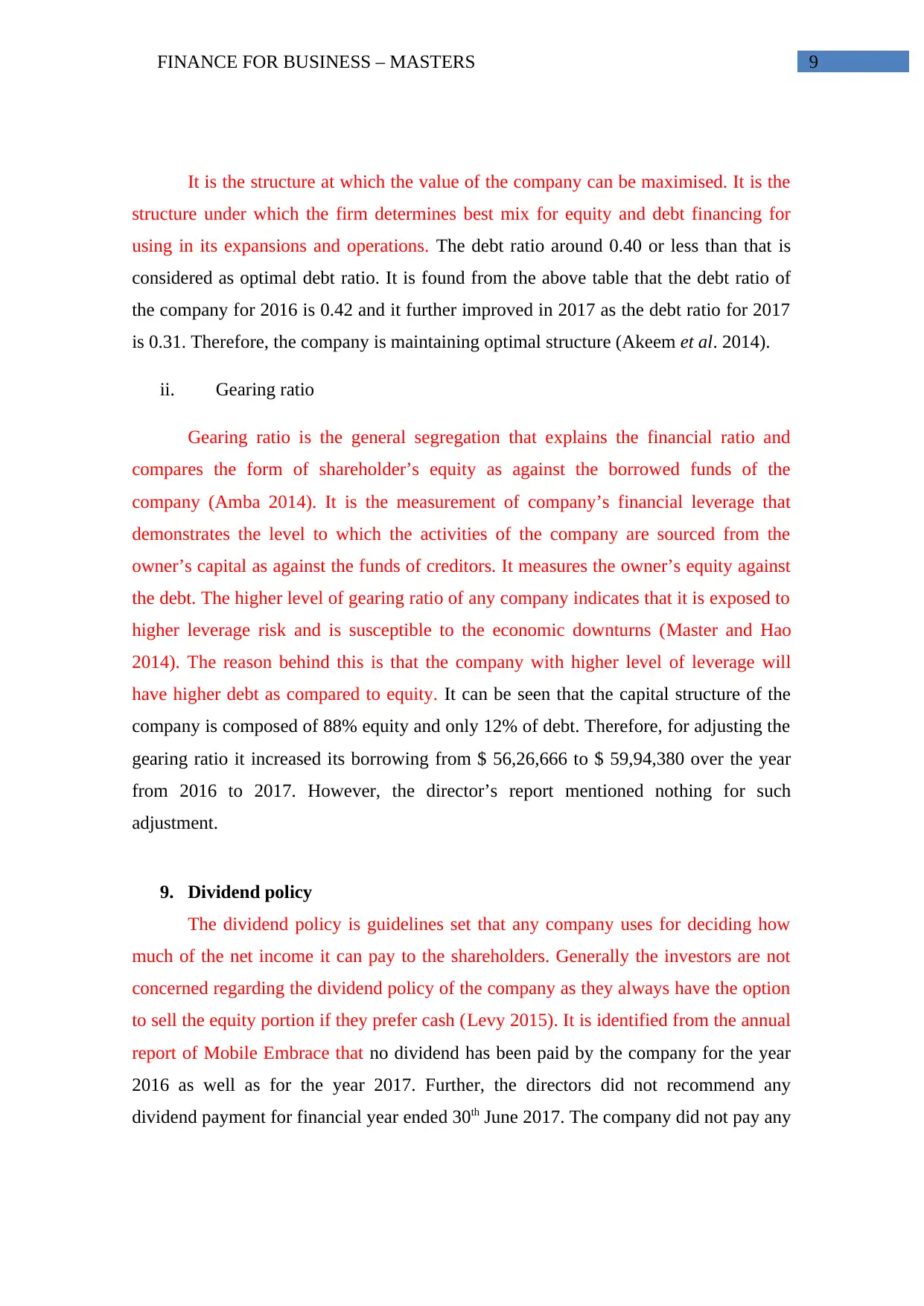
FINANCE FOR BUSINESS – MASTERS 9
It is the structure at which the value of the company can be maximised. It is the
structure under which the firm determines best mix for equity and debt financing for
using in its expansions and operations. The debt ratio around 0.40 or less than that is
considered as optimal debt ratio. It is found from the above table that the debt ratio of
the company for 2016 is 0.42 and it further improved in 2017 as the debt ratio for 2017
is 0.31. Therefore, the company is maintaining optimal structure (Akeem et al. 2014).
ii. Gearing ratio
Gearing ratio is the general segregation that explains the financial ratio and
compares the form of shareholder’s equity as against the borrowed funds of the
company (Amba 2014). It is the measurement of company’s financial leverage that
demonstrates the level to which the activities of the company are sourced from the
owner’s capital as against the funds of creditors. It measures the owner’s equity against
the debt. The higher level of gearing ratio of any company indicates that it is exposed to
higher leverage risk and is susceptible to the economic downturns (Master and Hao
2014). The reason behind this is that the company with higher level of leverage will
have higher debt as compared to equity. It can be seen that the capital structure of the
company is composed of 88% equity and only 12% of debt. Therefore, for adjusting the
gearing ratio it increased its borrowing from $ 56,26,666 to $ 59,94,380 over the year
from 2016 to 2017. However, the director’s report mentioned nothing for such
adjustment.
9. Dividend policy
The dividend policy is guidelines set that any company uses for deciding how
much of the net income it can pay to the shareholders. Generally the investors are not
concerned regarding the dividend policy of the company as they always have the option
to sell the equity portion if they prefer cash (Levy 2015). It is identified from the annual
report of Mobile Embrace that no dividend has been paid by the company for the year
2016 as well as for the year 2017. Further, the directors did not recommend any
dividend payment for financial year ended 30th June 2017. The company did not pay any
It is the structure at which the value of the company can be maximised. It is the
structure under which the firm determines best mix for equity and debt financing for
using in its expansions and operations. The debt ratio around 0.40 or less than that is
considered as optimal debt ratio. It is found from the above table that the debt ratio of
the company for 2016 is 0.42 and it further improved in 2017 as the debt ratio for 2017
is 0.31. Therefore, the company is maintaining optimal structure (Akeem et al. 2014).
ii. Gearing ratio
Gearing ratio is the general segregation that explains the financial ratio and
compares the form of shareholder’s equity as against the borrowed funds of the
company (Amba 2014). It is the measurement of company’s financial leverage that
demonstrates the level to which the activities of the company are sourced from the
owner’s capital as against the funds of creditors. It measures the owner’s equity against
the debt. The higher level of gearing ratio of any company indicates that it is exposed to
higher leverage risk and is susceptible to the economic downturns (Master and Hao
2014). The reason behind this is that the company with higher level of leverage will
have higher debt as compared to equity. It can be seen that the capital structure of the
company is composed of 88% equity and only 12% of debt. Therefore, for adjusting the
gearing ratio it increased its borrowing from $ 56,26,666 to $ 59,94,380 over the year
from 2016 to 2017. However, the director’s report mentioned nothing for such
adjustment.
9. Dividend policy
The dividend policy is guidelines set that any company uses for deciding how
much of the net income it can pay to the shareholders. Generally the investors are not
concerned regarding the dividend policy of the company as they always have the option
to sell the equity portion if they prefer cash (Levy 2015). It is identified from the annual
report of Mobile Embrace that no dividend has been paid by the company for the year
2016 as well as for the year 2017. Further, the directors did not recommend any
dividend payment for financial year ended 30th June 2017. The company did not pay any
Paraphrase This Document
Need a fresh take? Get an instant paraphrase of this document with our AI Paraphraser
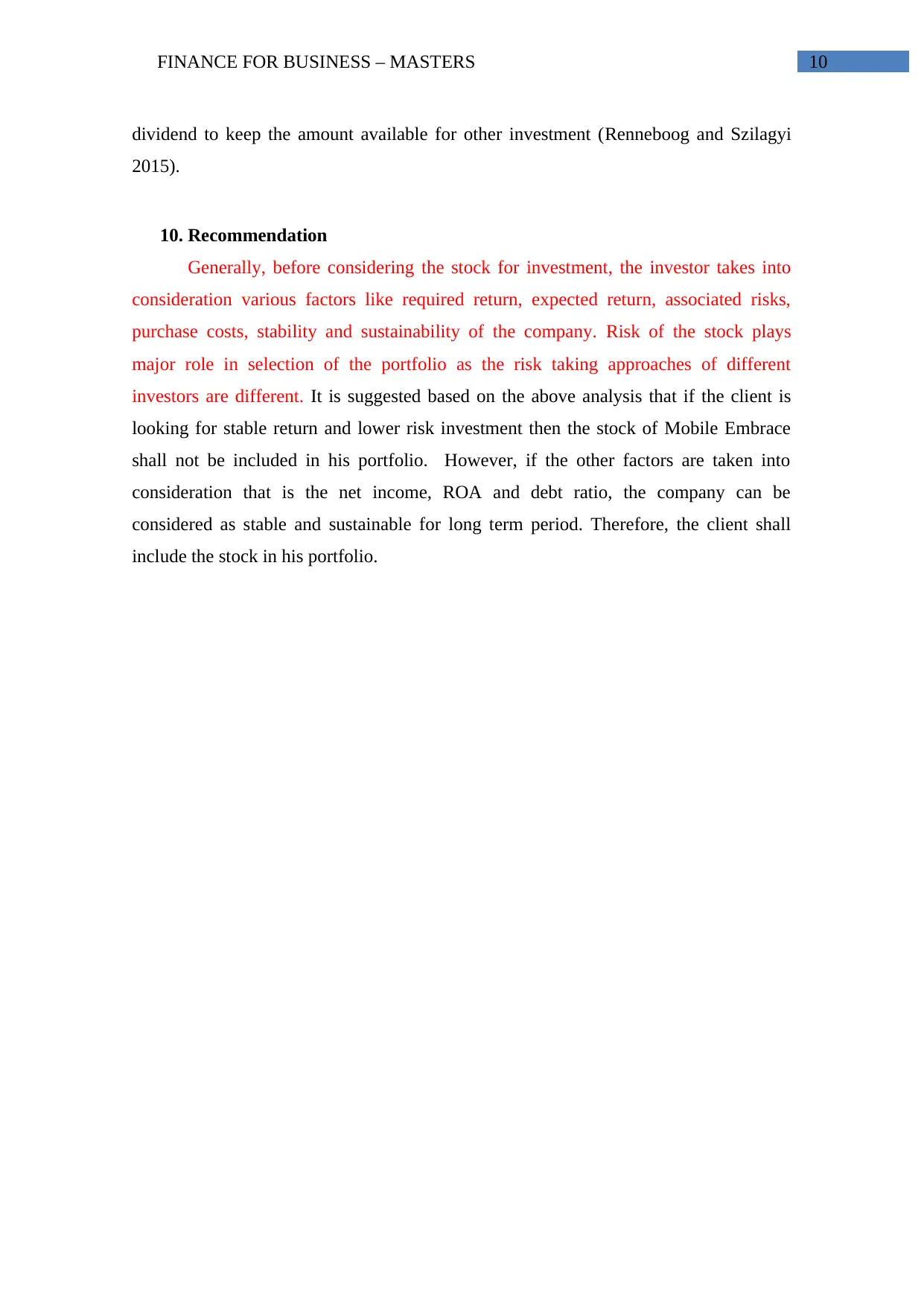
FINANCE FOR BUSINESS – MASTERS 10
dividend to keep the amount available for other investment (Renneboog and Szilagyi
2015).
10. Recommendation
Generally, before considering the stock for investment, the investor takes into
consideration various factors like required return, expected return, associated risks,
purchase costs, stability and sustainability of the company. Risk of the stock plays
major role in selection of the portfolio as the risk taking approaches of different
investors are different. It is suggested based on the above analysis that if the client is
looking for stable return and lower risk investment then the stock of Mobile Embrace
shall not be included in his portfolio. However, if the other factors are taken into
consideration that is the net income, ROA and debt ratio, the company can be
considered as stable and sustainable for long term period. Therefore, the client shall
include the stock in his portfolio.
dividend to keep the amount available for other investment (Renneboog and Szilagyi
2015).
10. Recommendation
Generally, before considering the stock for investment, the investor takes into
consideration various factors like required return, expected return, associated risks,
purchase costs, stability and sustainability of the company. Risk of the stock plays
major role in selection of the portfolio as the risk taking approaches of different
investors are different. It is suggested based on the above analysis that if the client is
looking for stable return and lower risk investment then the stock of Mobile Embrace
shall not be included in his portfolio. However, if the other factors are taken into
consideration that is the net income, ROA and debt ratio, the company can be
considered as stable and sustainable for long term period. Therefore, the client shall
include the stock in his portfolio.
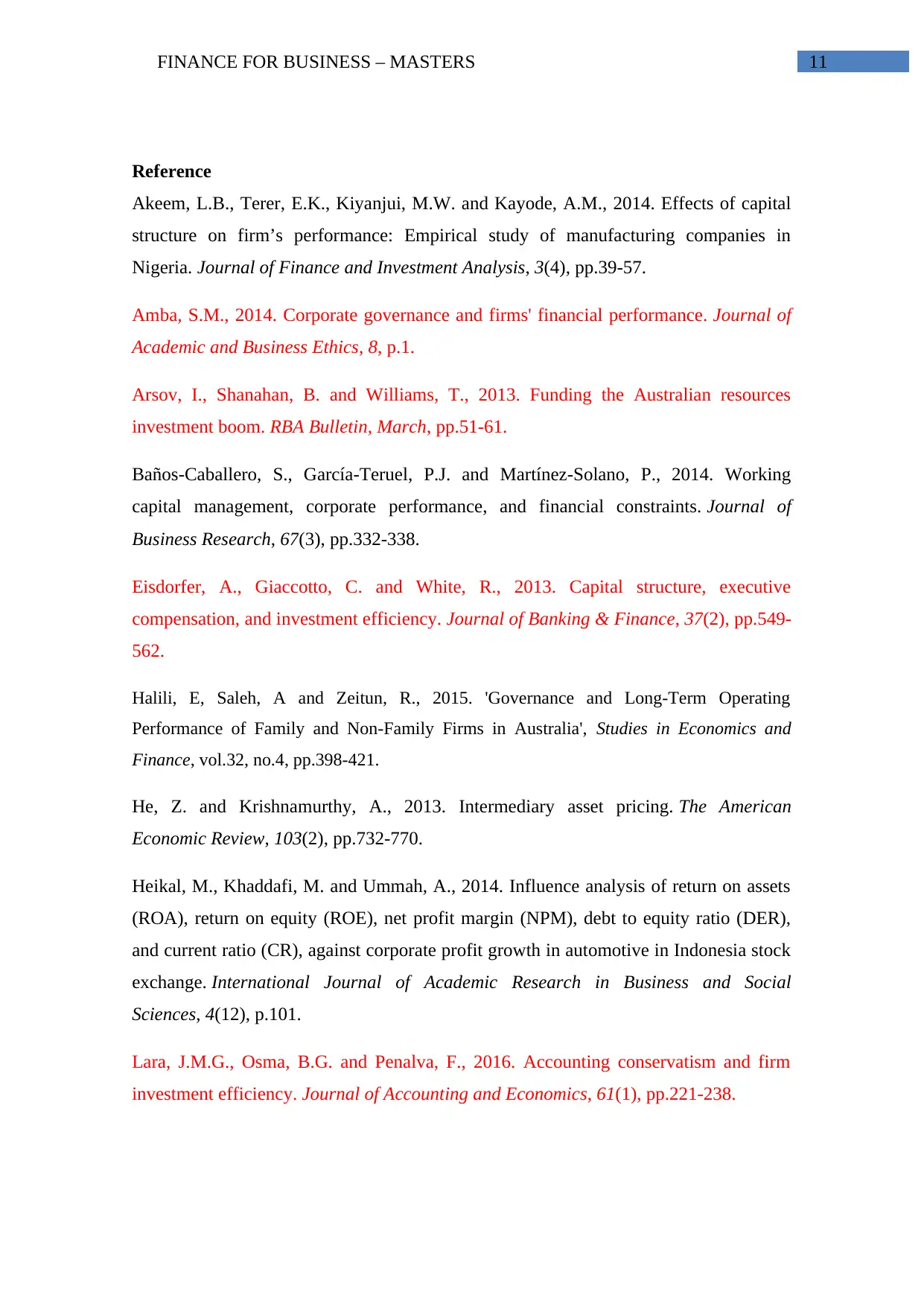
FINANCE FOR BUSINESS – MASTERS 11
Reference
Akeem, L.B., Terer, E.K., Kiyanjui, M.W. and Kayode, A.M., 2014. Effects of capital
structure on firm’s performance: Empirical study of manufacturing companies in
Nigeria. Journal of Finance and Investment Analysis, 3(4), pp.39-57.
Amba, S.M., 2014. Corporate governance and firms' financial performance. Journal of
Academic and Business Ethics, 8, p.1.
Arsov, I., Shanahan, B. and Williams, T., 2013. Funding the Australian resources
investment boom. RBA Bulletin, March, pp.51-61.
Baños-Caballero, S., García-Teruel, P.J. and Martínez-Solano, P., 2014. Working
capital management, corporate performance, and financial constraints. Journal of
Business Research, 67(3), pp.332-338.
Eisdorfer, A., Giaccotto, C. and White, R., 2013. Capital structure, executive
compensation, and investment efficiency. Journal of Banking & Finance, 37(2), pp.549-
562.
Halili, E, Saleh, A and Zeitun, R., 2015. 'Governance and Long-Term Operating
Performance of Family and Non-Family Firms in Australia', Studies in Economics and
Finance, vol.32, no.4, pp.398-421.
He, Z. and Krishnamurthy, A., 2013. Intermediary asset pricing. The American
Economic Review, 103(2), pp.732-770.
Heikal, M., Khaddafi, M. and Ummah, A., 2014. Influence analysis of return on assets
(ROA), return on equity (ROE), net profit margin (NPM), debt to equity ratio (DER),
and current ratio (CR), against corporate profit growth in automotive in Indonesia stock
exchange. International Journal of Academic Research in Business and Social
Sciences, 4(12), p.101.
Lara, J.M.G., Osma, B.G. and Penalva, F., 2016. Accounting conservatism and firm
investment efficiency. Journal of Accounting and Economics, 61(1), pp.221-238.
Reference
Akeem, L.B., Terer, E.K., Kiyanjui, M.W. and Kayode, A.M., 2014. Effects of capital
structure on firm’s performance: Empirical study of manufacturing companies in
Nigeria. Journal of Finance and Investment Analysis, 3(4), pp.39-57.
Amba, S.M., 2014. Corporate governance and firms' financial performance. Journal of
Academic and Business Ethics, 8, p.1.
Arsov, I., Shanahan, B. and Williams, T., 2013. Funding the Australian resources
investment boom. RBA Bulletin, March, pp.51-61.
Baños-Caballero, S., García-Teruel, P.J. and Martínez-Solano, P., 2014. Working
capital management, corporate performance, and financial constraints. Journal of
Business Research, 67(3), pp.332-338.
Eisdorfer, A., Giaccotto, C. and White, R., 2013. Capital structure, executive
compensation, and investment efficiency. Journal of Banking & Finance, 37(2), pp.549-
562.
Halili, E, Saleh, A and Zeitun, R., 2015. 'Governance and Long-Term Operating
Performance of Family and Non-Family Firms in Australia', Studies in Economics and
Finance, vol.32, no.4, pp.398-421.
He, Z. and Krishnamurthy, A., 2013. Intermediary asset pricing. The American
Economic Review, 103(2), pp.732-770.
Heikal, M., Khaddafi, M. and Ummah, A., 2014. Influence analysis of return on assets
(ROA), return on equity (ROE), net profit margin (NPM), debt to equity ratio (DER),
and current ratio (CR), against corporate profit growth in automotive in Indonesia stock
exchange. International Journal of Academic Research in Business and Social
Sciences, 4(12), p.101.
Lara, J.M.G., Osma, B.G. and Penalva, F., 2016. Accounting conservatism and firm
investment efficiency. Journal of Accounting and Economics, 61(1), pp.221-238.
⊘ This is a preview!⊘
Do you want full access?
Subscribe today to unlock all pages.

Trusted by 1+ million students worldwide
1 out of 13
Related Documents
Your All-in-One AI-Powered Toolkit for Academic Success.
+13062052269
info@desklib.com
Available 24*7 on WhatsApp / Email
![[object Object]](/_next/static/media/star-bottom.7253800d.svg)
Unlock your academic potential
Copyright © 2020–2025 A2Z Services. All Rights Reserved. Developed and managed by ZUCOL.





